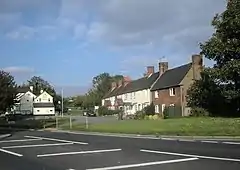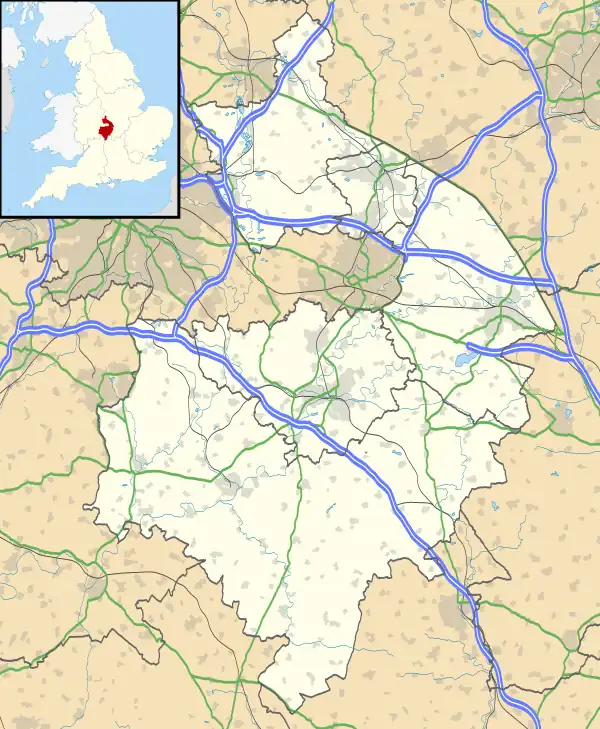| Princethorpe | |
|---|---|
 Buildings in Princethorpe | |
 Princethorpe Location within Warwickshire | |
| Population | 429 (2021) |
| OS grid reference | SP4068 |
| Civil parish |
|
| District | |
| Shire county | |
| Region | |
| Country | England |
| Sovereign state | United Kingdom |
| Post town | RUGBY |
| Postcode district | CV23 |
| Dialling code | 01926 |
| Police | Warwickshire |
| Fire | Warwickshire |
| Ambulance | West Midlands |
| UK Parliament | |
Princethorpe is a village and civil parish in the Rugby district of Warwickshire, England. In the 2011 census the parish had a population 376, increasing to 429 at the 2021 census.[1]
Princethorpe is located roughly halfway between the towns of Rugby 6.5 miles (10.5 km) to the north-east, and Leamington Spa 6 miles (9.7 km) to the south-west. It is at the centre of a busy junction between the A423 (Coventry to Banbury), B4453 (Rugby to Leamington) and B4455 (Fosse Way) roads. The village contains a pub called the Three Horseshoes, which has been in business continuously since at least 1816.[2] Situated on Leamington Road in the village is Our Lady's Primary School. It is a primary school with around 100 children between the ages of 4 and 11.
Just outside the village is Princethorpe College, a Roman Catholic school. The school incorporates the buildings of the former St. Mary's Priory, which was founded by French Benedictine nuns from Montargis who sought asylum from the French Revolution in 1792. After several moves, they settled in Princethorpe in 1832, and established a priory and school. In 1966 it was purchased by the Missionaries of the Sacred Heart who established it into its present form.[3][4][5]
The village has a history extending to at least the Roman period, related to the fact that the Fosse Way, an old Roman road ran through it. Two Roman settlements existed just south of the current village.[6][7] In the 1950s, a number of Roman coins were found in Princethorpe.[5]
Its name likely derived from an Anglo-Saxon farmer called Pren.[5] It was first mentioned in 1275–6.[8] In the reign of Henry VI it came into the possession of the Hugford family of Emscote and stayed in that family until the reign of Henry VII when John Hugford sold it to Sir William Compton. Princethorpe was originally in the parish of Wolston but was made, for convenience, a separate parish with Stretton by an Act of Parliament in 1694 the reign of William III. Princethorpe is today still part of the ecclesiastical parish of Stretton-on-Dunsmore,[9] but became a separate civil parish in 1866.[10]

 The Three Horseshoes, Princethorpe
The Three Horseshoes, Princethorpe
Notable people
Land-drainage reformer Joseph Elkington developed his drainage techniques while farming at Princethorpe.[11]
References
- ↑ "PRINCETHORPE Parish in West Midlands". City Population. Retrieved 11 December 2022.
- ↑ "The Three Horseshoes at Princethorpe". Our Warwickshire. Retrieved 11 December 2022.
- ↑ "Princethorpe College: Origins". Our Warwickshire. Retrieved 11 December 2022.
- ↑ "Princethorpe College: The Priory". Our Warwickshire. Retrieved 11 December 2022.
- 1 2 3 The Warwickshire Village Book. Countryside Books. 2000. pp. 150–152. ISBN 1-85306-652-4.
- ↑ "Site of Roman settlement 200m s of Princethorpe". Our Warwickshire. Retrieved 11 December 2022.
- ↑ "Site of Roman settlement 400m s of Priory Farm, Princethorpe". Our Warwickshire. Retrieved 11 December 2022.
- ↑ "Parishes: Stretton-upon-Dunsmore and Princethorpe". British History Online. Retrieved 11 December 2022.
- ↑ "Stretton-on-Dunsmore Warwickshire Family History Guide". Parishmouse Warwickshire. Retrieved 13 December 2022.
- ↑ "Princethorpe Tn/CP - Relationships and changes". Vision of Britain. Retrieved 13 December 2022.
- ↑ Upton, Chris (15 February 2013). "Farm engineer Joseph Elkington was an expert in his field". Birmingham Post. Retrieved 16 February 2013.